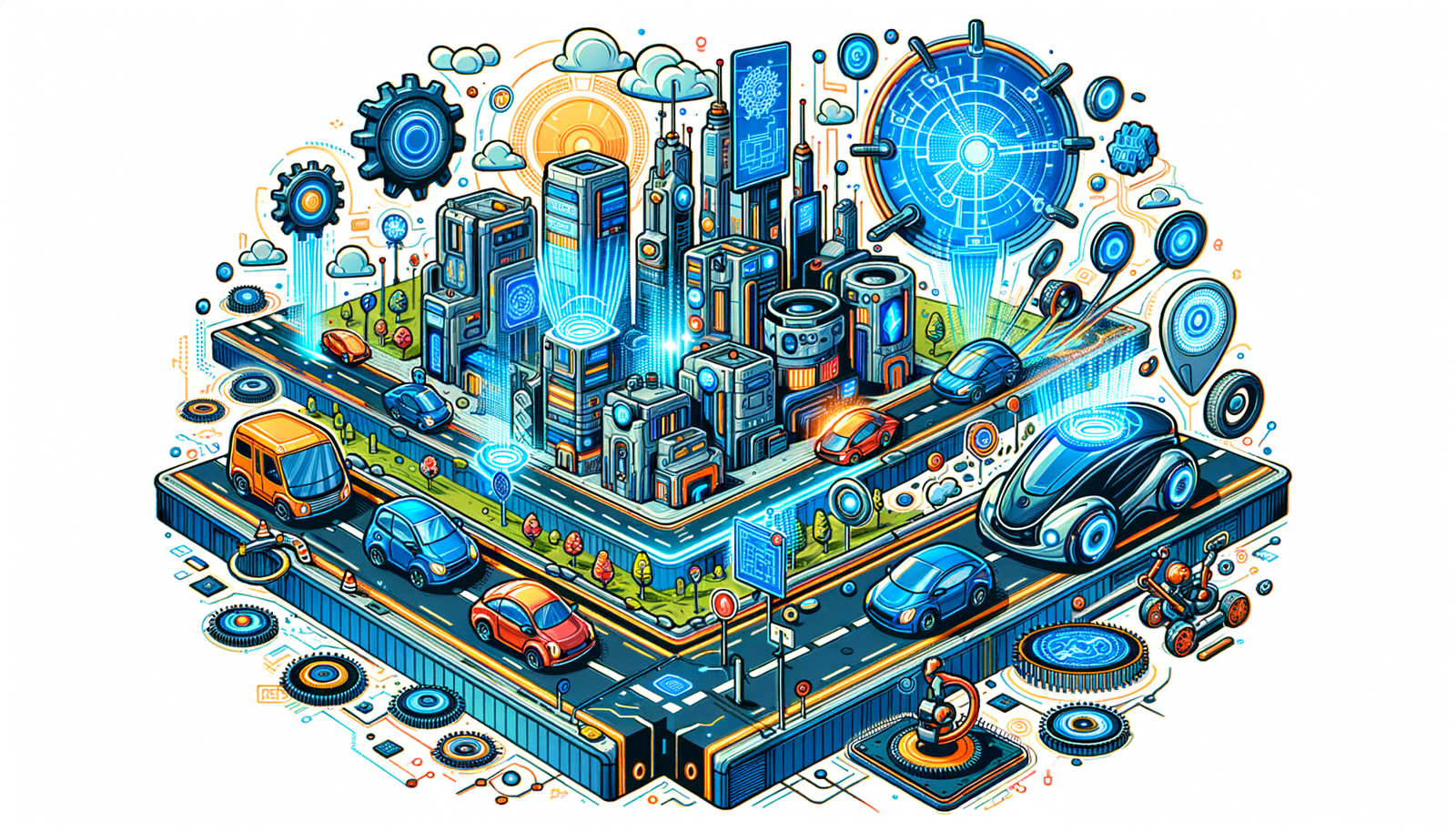Your Cart is Empty
Customer Testimonials
-
"Great customer service. The folks at Novedge were super helpful in navigating a somewhat complicated order including software upgrades and serial numbers in various stages of inactivity. They were friendly and helpful throughout the process.."
Ruben Ruckmark
"Quick & very helpful. We have been using Novedge for years and are very happy with their quick service when we need to make a purchase and excellent support resolving any issues."
Will Woodson
"Scott is the best. He reminds me about subscriptions dates, guides me in the correct direction for updates. He always responds promptly to me. He is literally the reason I continue to work with Novedge and will do so in the future."
Edward Mchugh
"Calvin Lok is “the man”. After my purchase of Sketchup 2021, he called me and provided step-by-step instructions to ease me through difficulties I was having with the setup of my new software."
Mike Borzage
Driving the Future: AI-Enhanced CAD for Automated Design Optimization
May 09, 2025 8 min read


Setting the Stage for Automated Design Optimization
Modern CAD Tools and Evolving Demands
The landscape of computer‐aided design has undergone dramatic transformations over the last few decades, evolving from simple drafting tools to complex systems replete with powerful simulation and visualization capabilities. Today’s modern CAD platforms not only enable detailed geometric modeling but also integrate state‐of‐the‐art computational methods to address increasingly complex design challenges. Industries ranging from aerospace engineering to architectural design are leveraging these modern platforms to push the boundaries of what is possible in design optimization and manufacturing. With the advent of **cloud‐based computing**, advanced algorithms, and real‐time visualization, designers are now equipped to iterate rapidly and produce designs that meet stringent performance, aesthetic, and functional specifications. Bulleted key advantages of modern CAD tools include:
- Enhanced precision and accuracy in modeling
- Seamless integration with simulation and analysis tools
- Improved collaboration through cloud integration
- Capability to handle complex geometries and large-scale data
In addition to these technical capabilities, the increased demand for customization, sustainability, and accelerated product development cycles has placed new pressures on conventional design processes. Design teams are increasingly expected to deliver not only visually compelling products, but also sustainable, efficient, and innovative solutions in a market that never sleeps. This elevated market expectation is prompting engineers, architects, and designers alike to rethink and redesign their workflows. Traditional methods, which once revolved primarily around manual adjustments and iterative hand-drawing steps, are rapidly giving way to more automated, systematic, and data-driven processes. In this context, the evolution of design software becomes not only an enabler but also a driver of competitive advantage in industries that are highly sensitive to performance metrics and time-to-market pressures.
Integrating Artificial Intelligence in Design Processes
At the heart of this transformation stands artificial intelligence (AI), poised to revolutionize how design problems are approached and solved. AI in design optimization extends beyond simple automation of repetitive tasks—it introduces an entirely new paradigm where learning algorithms can predict, simulate, and optimize outcomes with minimal human intervention. For example, by integrating neural networks, machine learning algorithms, and genetic algorithms, designers now have the capacity to explore an exponentially larger design space, identifying novel configurations that may have otherwise been overlooked. This approach is founded on the principle of **algorithmic automation**, which not only accelerates the design process but also significantly enhances innovation. Some of the core aspects of AI integration into design practices include:
- Predictive analytics to forecast performance outcomes
- Adaptive simulation models that evolve with new data
- Automated iterations that refine designs to meet target specifications
- Generative design techniques that produce multiple promising alternatives
The transition from manual design to AI-powered approaches has introduced a fundamentally different paradigm in design thinking. While traditional methods were typically linear—beginning with concept development and moving sequentially through iterations—AI-based models encourage parallel exploration and simultaneous evaluation of multiple design variants. This shift not only improves efficiency but also opens up new avenues for innovation, as the integration of automated systems can reveal optimal solutions that might not have been feasible from a strictly manual perspective. In these ways, artificial intelligence is not merely a tool for performing calculations and simulations faster; it is a transformative enabler that reshapes how ideas are conceptualized, validated, and ultimately brought to market.
AI Methodologies Driving Optimization in CAD
Core AI Techniques in Design Optimization
Advancements in AI have provided an expansive toolkit to tackle the multi-faceted challenges of design optimization in CAD environments. Among these, machine learning, neural networks, and genetic algorithms have emerged as principal methodologies due to their capacity to handle complex, non-linear problems that traditionally required exhaustive manual tuning. Machine learning algorithms, in particular, play an instrumental role by learning patterns from vast sets of historical design data and predicting outcomes for new scenarios. This predictive capability enables designers to identify potential issues and fine-tune parameters proactively. In a similar context, neural networks contribute through their ability to approximate complex mathematical functions that describe physical phenomena, thereby offering a powerful method to simulate real-world performance in virtual environments. Meanwhile, genetic algorithms incorporate the concepts of natural evolution to iteratively converge on optimal design solutions, mimicking processes such as mutation, crossover, and selection to evolve a population of candidate designs over successive iterations.
By harnessing these AI techniques, modern CAD tools are capable of performing what was once a labor-intensive process in a fraction of the time. For instance, **generative design** algorithms enable the simultaneous exploration of thousands of potential design alternatives, rapidly narrowing down the options to those that best meet predefined criteria. Similarly, **topology optimization** is redefined through machine learning models that dynamically adapt design constraints based on performance feedback, resulting in structures that are both lightweight and robust. Key benefits resulting from these methodologies include:
- Significant reduction in design cycle times
- Enhanced performance through iterative optimization
- Tangible cost savings by reducing the dependency on physical prototyping
- Unprecedented levels of innovation through expansive design exploration
Implementing Algorithmic Automation in CAD
The transformative power of algorithmic automation is clearly visible in the integration of generative design and topology optimization within CAD software. Generative design utilizes predictive models and data analytics to automatically generate a multitude of design alternatives based on input constraints and performance criteria. The designer’s role transitions from manual model adjustments to selecting and refining the most promising options proposed by the system. This shift is underpinned by sophisticated machine learning algorithms that continuously improve their understanding of design trade-offs. Moreover, topology optimization, which seeks to determine the optimal material layout within a given design space, has been enhanced by the use of neural network frameworks that can swiftly analyze simulated data and recommend modifications. These technologies allow for:
- Rapid prototyping of high-performance design alternatives
- Enhanced performance and reliability in final products
- Integration of multi-disciplinary constraints in a unified simulation environment
- Adaptive learning from ongoing design iterations and real-time data feedback
As these techniques continuously evolve, the boundary between human intuition and machine computation becomes increasingly blurred. Modern CAD systems are now designed to function as collaborative partners—tools that not only assist but actively contribute to the design process by offering data-driven insights and recommendations. This symbiotic relationship is crucial as industries increasingly rely on **AI-powered automation** to meet the challenges of rapid innovation and market complexity. In this new environment, designers are empowered to focus more on creative problem-solving and less on repetitive tasks, ultimately leading to richer, more optimized outputs that balance performance with aesthetics.
Benefits, Challenges, and Real-World Applications
Advantages of Leveraging AI in CAD
Leveraging artificial intelligence in CAD environments yields transformative benefits across several dimensions of the product development process. One significant advantage is the marked improvement in design accuracy: by employing algorithms capable of processing and learning from massive data sets, designers can achieve levels of precision that exceed traditional manual approaches. This precision is particularly critical in fields such as aerospace or automotive design, where even minor discrepancies can lead to severe performance or safety issues. Equally, the speed of design iteration is enhanced dramatically through the use of AI-driven automation, reducing the time required to simulate, evaluate, and refine design options. As a result, companies can not only cut development cycles but also react more adeptly to changing market demands and technological innovations. Some of the primary benefits of this approach include:
- Improved design accuracy through data-driven insights
- Accelerated iteration cycles, reducing time-to-market
- Enhanced resource efficiency by minimizing waste in the prototyping stage
- Increased innovation potential by exploring complex design spaces automatically
The use of AI in CAD also results in a more efficient allocation of human and computational resources. Instead of spending countless hours on repetitive tasks, engineers and designers can now concentrate on high-level problem solving and creative innovation. This shift in focus not only fosters a more dynamic workflow but also increases the overall value generation within organizations—through faster product development timelines and cost-efficient, optimized designs. Furthermore, the insights gleaned from AI algorithms enable better prediction of product behavior under different operating conditions, leading to safer and more reliable designs. As a consequence, industries that adopt these advanced optimization techniques are finding themselves better equipped to manage risk, reduce errors, and maintain competitive advantages in rapidly evolving markets.
Challenges and Practical Considerations
Despite the clear benefits, the integration of AI into CAD systems is not without its challenges. One persistent issue is the need for high-quality, comprehensive data sets to train machine learning models effectively. Without robust data, the predictive power of neural networks and other AI algorithms can be severely compromised, leading to suboptimal design outcomes. Additionally, the computational demands of these sophisticated models often require significant investments in hardware and cloud-based infrastructure, posing an access barrier for smaller firms or those operating under tight budget constraints. Another challenge is the user adaptation curve—designers accustomed to traditional methods may initially find it difficult to transition to an AI-enhanced workflow, where decision-making processes are partly delegated to automated systems. A few other practical challenges include:
- Data quality and availability issues
- High computational resource requirements
- The need for ongoing training and upskilling in AI techniques
- Integration complexities with legacy systems
These challenges require careful planning and strategic investment. Enterprises that successfully integrate AI into their design processes typically adopt a phased approach, gradually scaling up from pilot projects to more comprehensive implementations. This measured rollout allows teams to develop the necessary expertise while also evaluating the return on investment across successive iterations. Furthermore, industry leaders are increasingly emphasizing collaborative solutions that pair experienced human designers with advanced AI tools, creating a balanced dynamic that harnesses the strengths of both. This fusion of machine intelligence and human creativity not only mitigates the inherent risks of transitioning to a fully automated workflow but also ensures that the final design outputs are both innovative and pragmatic.
Conclusion
Reshaping Design Optimization
In conclusion, the integration of artificial intelligence into CAD environments is redefining the very nature of design optimization. By transforming traditional workflows with techniques such as machine learning, neural networks, and genetic algorithms, the industry has experienced significant leaps in precision, efficiency, and innovation. AI not only automates repetitive tasks but also empowers designers to explore and evaluate vast design spaces in ways that manual processes could never achieve. The amalgamation of **generative design** and **topology optimization** with AI techniques has resulted in solutions that outperform traditional methods both in performance and in meeting complex design criteria. This evolution reflects a broader trend toward data-centric, algorithm-driven processes that are set to become the norm across many engineering and design disciplines.
Future Trends and Balancing Innovation
Looking forward, the trajectory of AI-driven design is poised to continue its upward ascent as emerging technologies and improved computational capabilities converge to unlock new possibilities. Future trends are likely to include deeper integrations of real-time data analytics, expanded use of augmented and virtual reality for enhanced visualization, and further democratization of high-powered design tools through cloud-based platforms. The continued evolution of AI in design is expected to drive innovations that not only increase efficiency but also uncover entirely new paradigms in engineering and architectural creativity. However, while automated processes offer remarkable benefits, they must be balanced with human-centric insights, ensuring that creativity and critical thinking remain at the forefront of the design process. Among the strategies to maintain this equilibrium are:
- Enhancing collaborative interfaces that blend AI recommendations with designer expertise
- Ongoing professional development to familiarize teams with emerging technologies
- Rigorous evaluation protocols that pair algorithmic outputs with human judgment
- Adoption of flexible, adaptive workflows that allow for iterative refinement
In essence, the future of AI in CAD is not about replacing human ingenuity but rather expanding its potential by removing mundane complexities and enabling more strategic, impactful design decisions. The next generation of design optimization tools will likely embody this balanced approach, where advanced algorithms empower designers to take bold leaps forward while preserving the critical role of human creativity and insight. This integrated vision promises not only faster, more efficient product development cycles but also solutions that are both technically superior and aesthetically resonant.
Final Thoughts on Automated Innovation versus Human-Centric Design
Ultimately, the journey of integrating AI into design processes embodies a delicate balance between **automated innovation** and human-centric creativity. While the advantages of rapid iteration and expanded design exploration catalyze unprecedented developments, the value of human intuition remains indispensable. In this era of transformation, the most successful organizations will be those that can harness the capabilities of advanced AI methodologies while nurturing a culture that prizes creative problem-solving and experiential insights. The future of design, whether it be in engineering, additive manufacturing, or architectural visualization, will depend on the harmonious interplay of these complementary forces. As technology continues to evolve at a breakneck pace, maintaining this balance will be key to unlocking sustainable, long-term growth in the field of design optimization.
Also in Design News

Cinema 4D Tip: Turbulence Field for Fast, Art‑Directable Organic Motion
December 27, 2025 2 min read
Read More
V-Ray Tip: Curvature and AO Masks for Realistic Material Wear
December 27, 2025 2 min read
Read MoreSubscribe
Sign up to get the latest on sales, new releases and more …



